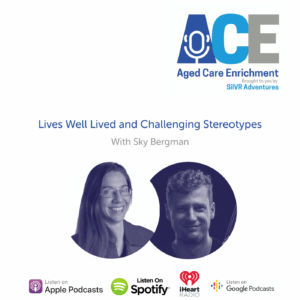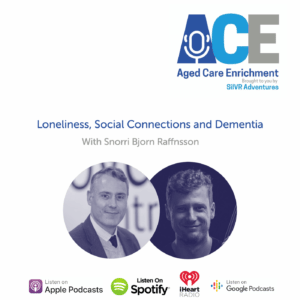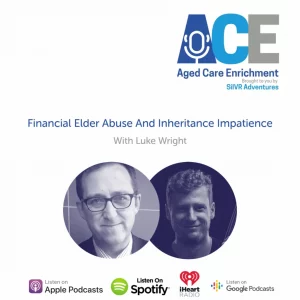Transcript
Ash de Neef: All right. Well, Kerryn, Richard, thank you so much for your time today.
Kerryn Dillon: Thanks Ash
Richard Ainley: Thanks Ash, great to be with you.
Ash de Neef: Yeah, great to have you guys here. And maybe we could start, Kerryn could you lead us off – who are you? What do you do? What’s your story?
Kerryn Dillon: So I’ve been with PWC now for just over six months. I’m a director in the health and wellbeing team. I work specifically in the aged care part of our business, really looking to support and build our firm as far as giving support to the sector during this time of disruption and transformation. Prior to joining PWC, I’ve actually spent most of my career working in health and aged care.
So really, working on the ground, boots on the ground, working with residents, patients, and staff in both the health and aged care.
Ash de Neef: Fantastic Richard. What’s your story?
Richard Ainley: So Ash, I’ve been with PWC for a little longer. I actually joined the firm about 18 months ago as the lead consulting partner for ageing and re-ablement nationally. And that marks about the 25th year or so that I’ve been involved in the health and aged care industry. I’ve spent the last 10 years in consulting and before that another 10 or so in hospital, health services and aged care management.
And once upon a time I was actually a physiotherapist back in the day. Definitely not safe to practice clinically anymore, but I hope I still remember some of the things that I learned as a clinician, caring for patients and residents.
So actually the first job I ever had in the healthcare industry was an allied health assistant, at Northwest hospital in Parkville, Melbourne. Which was part of the aged care services there. So that was a little while ago now.
Ash de Neef: Great. And for our listeners who work within the aged care space, can we maybe give an overview of what kind of work does PWC do in this space? How does that relate to people who are working within the industry? Feel free either of you to jump in here.
Richard Ainley: Kerryn and I work with the consulting team at PWC. We also have a team in the assurance area and also in financial advisory. And we’re involved in almost every aspect of the aged care industry and working with our clients. And so that can, span, for Kerryn and I, areas such as advising Commonwealth on the design implementation of new programs and reforms. Some of those coming out of the Royal commission and the five pillar plan that we’re going to talk about today. It can involve working directly with providers in areas like strategy, performance improvement and transformation.
And of course right now, focusing on working with our clients to navigate what is a really important time of change both now and into the future for ageing and aged care in Australia.
Kerryn Dillon: And I think it’s really important to know that ageing and re-ablement for our firm is a real priority. We see it as an area that really could benefit from our support and our assistance and, and that the sector is really calling out for. So we really plan to continue to focus our efforts in that space.
Ash de Neef: Fantastic. Now, Rich, you alluded there very nicely to a topic I really want to talk about today. Which is after the Royal commission’s final report came out, this government proposed the five pillars plan. Speaking broadly, I’d like to get into specifics a little bit later, but Kerryn, maybe you can lead off. What can people expect in terms of changes out of this five pillar plan of how they affect providers in the workforce?
Kerryn Dillon: Well, I think the Aged Care Royal Commission was of course, a bit of a watershed moment for the sector, and the response from the federal government has been significant with $17.6 billion worth of investment being planned over the next five years. The five pillar plan and everything that comes with it will be significant for the sector, and we’re starting to see the impacts of that now. Although in the next few years is really when we’re going to see how much it really affects the sector. It’ll affect things across from funding to workforce requirements, to infrastructure, and the models and delivery of care, the difference between home care and the residential aged care setting.
So it is going to be quite a significant and potentially unsettling time for the sector. We’re yet to see the true ramifications of the five pillar plan, but it’s definitely coming, and the sector is anxiously waiting for more information and more programs to roll out from the government.
Ash de Neef: Mmm. I think what you’ve mentioned there as well, that change won’t come immediately, but it’ll trickle in and it’ll probably trickle from the top down that organisational structure at the very top, will notice the changes first. And that’ll filter to staff, and then that will term of filter to residents and care recipients.
How will these, you know, this free refocusing on the individual desires, will that affect people at the very top board members and the such Kerryn?
Kerryn Dillon: Well as part of the five-year plan, there is a major focus on governance within aged care. And that’s actually one of the areas that our assurance team particularly does a lot of work in. What we’ve seen traditionally in the aged care sector is particularly community based boards where, really well-meaning members of the community sit on the board to help govern aged care providers. The challenge with that is that they don’t necessarily have the skills and knowledge and experience to ensure that the standards of governance that we would expect of a provider such as an aged care provider are being met.
So there will be a huge program of work to seek to up-skill the quality of boards governing aged care. And then that in turn will ensure ongoing accountability, both at the board level, the executive level and right through the organisation. What that in turn should impact is the overall quality of care. And the idea is ultimately we’ll see less and less of these tragic and very sad stories emerge. Some of which we’ve seen through the Aged Care Royal Commission
Ash de Neef: Hmm, it sounds like through these up-skilling and perhaps reshaping of the boards that you might see people who would ordinarily be on the board, be moved out there might be a sort of different representation there. Do you think there’s any risk of people who have maybe more of a vested stake in being a part of the board being pushed out by this?
Richard Ainley: I’m not so sure that it’s always an issue of being pushed out. I think it’s a question of really of good governance of the organisations. As Kerryn said there are increasing expectations, that all organisations and their boards of governance, meet the sort of standards that, the community and funders, expect of them. And it’s a question of do they have the right balance, and how are they performing? And in many cases, what was identified through the process of the Royal Commission was there was a gaps, particularly in terms of what’s called clinical governance.
And that was really, I think also a reflection of the way that the community is changing and the industry is changing. So aged care today, particularly residential aged care, is far more complex. The needs of residents are more clinically complex, and requires perhaps a different skillset to what was say 10, 20 years ago in this industry.
The average stay in residential aged care for most people is significantly shorter than it used to be. They’re entering sicker, entering older, and that creates a different set of burdens on the organisation for having the right expertise.
Not just at the point of care, that’s also required at the board level, to understand, to monitor, to assure. And to make sure that there’s a process of both accountability and improvement across the organisation in those areas.
Ash de Neef: That’s a really important point to point out that aged care is not this fixed thing, and the demographic that it served is not a fixed thing either. It is shifting and the needs of people who are engaging aged care services are shifting too.
One thing that might need to adapt to embrace these shifting needs is the model by which we’re delivering care, whether that’s the traditional residential model, or retirement living, or some combination of the two with home care.
Are either of you seeing any interesting or innovative models coming out currently might propose an alternative? Kerryn do you want to jump in?
Kerryn Dillon: Sure. So I think providers particularly are looking at lots of different options as far as how they deliver care. Because at the end of the day, it is about making sure they’re meeting the needs of the demographic. And as the baby boomer generation moves through this particular cohort, their expectations of care are much, much higher.
So we are seeing some really innovative models of care, small home models, where we have a reasonably small house or home like setting where there’s a small number of residents and dedicated staff living within that small home setting. We’re seeing a much higher quality of the traditional residential aged care setting where there’s lots of ancillary services. Like a gymnasium and virtual reality theater and all sorts of things for the residents of sense of lifestyle and things like that.
I think the most interesting thing coming out of the baby boomer generation though, is this real focus and preference to be cared for at home for as long as possible. And that’s what’s feeding into residents moving into aged care a lot older and a lot sicker and with a lot shorter length of stay. Because they’d much prefer to stay at home as long as they can.
So I think there’s lots of opportunity in that connection between home care and the rest of the health care sector, particularly acute subacute and allied health services. As well as opportunity to really leverage the emerging digital technologies that are coming out in this space for remote monitoring and care. To really make sure that people who choose to age at home and require that additional support at home, can do so in a safe environment for as long as they can.
Ash de Neef: Yeah, absolutely. Rich anything to add there?
Richard Ainley: Oh, look, I think Kerryn’s framed that really well. Perhaps the other couple of aspects to touch on there as well. In terms of the different ways of providing care, accommodation support, across the industry and across the community, are also being driven by, I think a recognition and an expectation that this is not just about providing care.
It’s also about providing well-being, fulfillment experiences, that enrich the lives of the people receiving the services. And also their families in a way that perhaps previously was more viewed as a one size fits all model. Certainly the way that the reforms are intended to progress is intended to facilitate flexibility and choice.
And some of the ideas and innovations that Kerryn touched on there. And of course it’s worth noting, as came out in the proceedings of the Royal Commission, there are a range of innovative models that are already in place. There are providers that are not waiting for reforms to role for over a matter of years and are pursuing some really innovative ideas.
And, again the sorts of things I think that are really exciting to see coming through.
Ash de Neef: Absolutely. I guess I wanted to bring up this topic of new models and new directions, because one thing that’s included – or several things that are included in the five pillars plan – is a lot more staffing hours. There are minimum care times, there are requirements of staff need to be here at this time.
This is putting an increased burden on the system providers. Can they in your opinion working with providers, do you think that the models and the finance at the moment are sufficient to allow for this increase in workload?
Richard Ainley: Kerryn you know a whole lot more about this topic so I’m gonna hand over to you.
Kerryn Dillon: Ahh thanks Rich. Yeah, it is absolutely near and dear to my heart as a HR professional by background. I walked the floors, with the aged care workforce and there are just some amazing people who work in aged care. And that was one of the things that made me particularly sad coming out of the Royal Commission is a lot of staff really didn’t have a great experience of the public information that came out.
And, I certainly am aware of people I know who were the subject of all sorts of jibes and language towards them in public settings, like supermarkets because they had their aged uniform on. So, I think it’s really important to note that nobody works in aged care because I want to do a bad job. They work because they’re there for the residents they’re there to provide care.
I think though, part of the pressure that’s on the aged care workforce is this whole concept of the rising acuity of residents, as they move into aged care. They’re being asked to do more and more with the same resources and often with the same rostering. Which makes it very, very difficult to provide that same quality person centred care and to make sure that they’re recognising deteriorations and changes as they age their health journey continues.
One of the challenges for the sector is the extreme workforce shortages that we’re seeing across the country. The aged care workforce is one of the largest service across Australia, and they get a bit of a bad rap. It is really hard work, it’s very physical work. The wages need a review and I think we’re all really happy to see that through the fair work commission, work value case. And hopefully that will have a significant effect on trying to drive people back into aged care. It is such a rewarding career, but if is a challenging environment to work in.
So I think as providers continue to look at opportunities for flexibility and innovation and driving through the very fundamental concepts underlying the five pillar plan, and the recommendations from the Royal Commission. We will start making aged care a much more attractive career proposition, so that we can start addressing some of those workforce shortages and really ensure that the quality of care that older Australians expect and should expect can be delivered by the workforce.
Ash de Neef: Mmm, to stay with you here Kerryn. Looking at the five pillar plan it seems like there is an increased workload as we’ve both said, but there doesn’t seem to be a substantial program for increasing the workforce size and addressing that problem. I would be concerned that for listeners who are working on the floors as as you were saying before they might just feel like this new plan means more work more stress tighter deadlines. Is that the reality going forward or is there something to be hopeful about?
Kerryn Dillon: Well, I think there’s lots of opportunity. I think I heard recently there’s something like 14,000 students who have completed their certificate three in individual support who are trying to get a place. Because they have do a four week placement in an aged care facility before they get the certificate.
For me, that’s really hopeful as far as the continued push of workforce and people seeking to be part of the aged care workforce. I think there is also a lot of attraction for the aged care workers. It’s a really stable place to work. Out of the COVID pandemic, so many people lost their jobs that were out of work whereas there was more demand than ever for aged care staff and certainly staff across the health sector.
I think if we can really lift the perception of aged care in the community, then it becomes again that much more attractive career pathway. And I know providers generally are looking at ways that they can create career pathways for staff to make sure that they can progress their career, and progress their skills through their employment in aged care.
So there is a lot of hope for the sector. And again the demographic of the aged care workforce, they are really special people and they are really caring people. So, continuing to build how aged care is perceived in the workforce and making sure that people understand how valuable that role is, I think will help drive people towards that as opposed to a way from aged care.
Ash de Neef: Mmm. Rich from your point of view working with management and governments, what can boards and managers and sort of upper structures of an organisation do to support the workforce through this time of change?
Richard Ainley: The providers that we speak to that are doing this well or managing this well, are those that are focusing on just getting the simple things right about supporting their teams. Supporting managers to support their teams, investing where they can albeit within limited resources at the moment because of all the other costs of delivering care, support and accommodation in this environment.
Getting those little things right. And attempting to sustain and build a positive and engaged workforce environment, despite all the challenges that sit outside the sector, and individual providers are facing every day.
The other challenge that providers, you know, management and boards face at the moment, is there is the promise of reform and investment in workforce and change and so forth as part of the plan. But really we talked earlier about lag time between the commitment to change and when the resident and the family experience it, the workforce is exactly the same.
So the two key elements that I think are going to make the biggest difference for workforce locally, are the new funding model that is currently being developed that will roll through. That will ultimately impact how, workforce, uh, You supported financially. And the the Fair Work Australia case that will determine what sorts of wages the industry can expect into the future
And those two things, despite all the little things that providers can do and the work that can be done locally, those two things are going to have a significant impact on the aged care workforce going forward. Of course alongside some of the other reforms that have been announced in the five pillar plan in terms of investing in workforce development, in career pathways in more attractive roles at various different levels in the industry.
So there’s a lot to come in this space, but equally, it will challenge providers and management teams to think about, “well, how can I support engage my staff right now with relatively limited resources and massive pressures, both inside and outside the industry.”
Kerryn Dillon: I think what providers can be doing right now while they’re waiting for the reforms to really take effect is to start looking at their overall employee experience and the employee value proposition. What are the things that they can offer that are really are a positive and a big benefit to the staff.
Is it flexibility? Is it innovation? Are there some, you know, if you’re not for profit, you can offer salary packaging. So there are some things that are already on the table that can really be focused on as far as looking for opportunities to improve and, really refine the employee experience to make it a more attractive proposition for the workforce.
Ash de Neef: Hmm. Yeah It’s nice to add some sort of tools there as well. I’m wondering throughout all the challenges and the the noise if you will that Rich was outlining, would they be a through message that can kind of cut through all this to keep people focused on what they’re doing and feeling good about their work?
Kerryn Dillon: I think it’s about the aged care workforce remembering how important their role is and what they’re doing each and every day. They have an impact on the residents quality of life and their experience, as I said every day. And I think that’s one of the things that keeps people coming back to work in aged care.
The benefit of working in aged care is that you can develop a long-term relationship with residents and their families, and really get to know them as people and understand what makes them happy? What makes them sad? And how you can really improve that overall experience. So I think that’s really important to remember, while, as you say, all the noise goes on around the aged care work.
Ash de Neef: So with all these sort of spot fires and and short-term problems to be focusing on, how can aged care providers also focus on the future at the same time?
Richard Ainley: Yeah, thanks, Ash. I think a question that certainly we’ve been wrestling with and our clients have been wrestling with since almost the beginning of the Royal Commission. A recognition that this was going to be a time of, and is now, a time of significant change. But providers need to be thinking about, “all right, what does the future look like?” It’s not, going to be the same industry in five to ten years as what we face today.
The keys to success are going to be different. We have spent some time talking to providers and thinking about what are the different elements of that. And we’ve. developed a methodology or an approach that picks up on some of the key areas that, many of which we’ve touched on today. And that is having a clear vision and a strategy and a direction for the future, and underpinning that with a sound financial and operational basis.
But beyond those business sides being anchored around this idea of the holistic experience for the person, and their family, that really goes beyond that one size fits all model of the past. And key to that, the fourth area that we’ve spent a bit of time talking about today’s is how the workforce is engaged ultimately as the way in which that experience is delivered.
And then the fifth of the five elements of the way that we think about transformation in aged care is the critical element of infrastructure. And again, just touching on that earlier point around, aged care being about more than just care. It’s about every aspect of well-being and fulfillment for older Australians. The place and the built form the physical environment is key.
It’s also key to having a sustainable operation, as well. And so getting that infrastructure component right, whether it’s digital, whether it’s around thinking about physical environment, facility design might be. All of those elements play into ultimately that overall experience, that ultimately providers are going to need to be delivering. To meet expectations and be competitive in what will be a much more competitive aged care environment in Australia.
Ash de Neef: Lots of different areas to focus on there, in terms of preparing for the future. Rich and Kerryn we’ve we’ve covered a lot and I feel like we’ve looked at a couple of different issues and the future from a few different lenses here, this has been great great. For our audience who might want to learn a bit more about what you guys are doing and what we’re talking about today, where can they go to find out more information?
Kerryn Dillon: Well the best place to start would be PWCs website. We’ve got a whole lot of information around our work in aged care available there. And of course they could get in touch directly with either Rich or myself, or one of the team.
Ash de Neef: Well Kerryn Rich thank you so much for your time today
Kerryn Dillon: Thanks Ash.
Richard Ainley: Thanks Ash.






